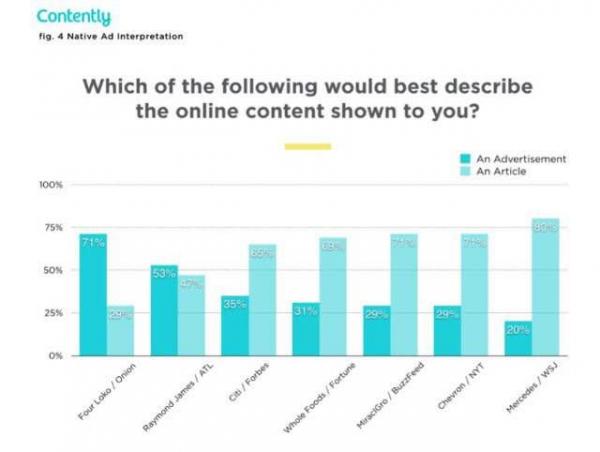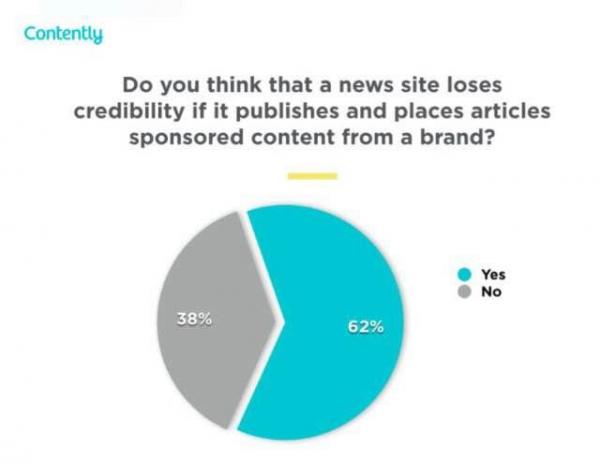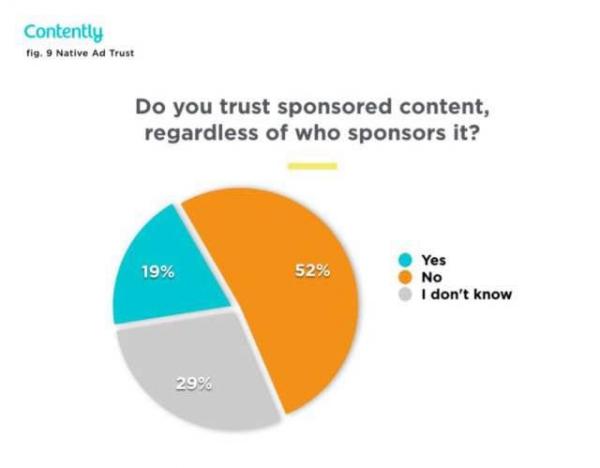Native advertising has become a preferred choice for many companies, with better performance than traditional ads on a number of sites. Still, native ads are facing challenges that are shifting public opinion of the form into a negative direction.
Contently recently surveyed over 500 consumers using native ads across various sites, including BuzzFeed, The New York Times and the Wall Street Journal. The poll results showed that different publications had varying degrees of issues with distinguishing an article from paid content.

“On nearly every publication we tested, consumers tend to identify native advertising as an article, not an advertisement,” the study concluded.
62 percent of respondents also felt that a news site manages to lose credibility any time it publishes a native ad, since it’s intertwined with editorial content. “Consumers often have a difficult time identifying the brand associated with a piece of native advertising, but it varies greatly, from as low as 63 percent (on The Onion) to as high as 88 percent (on Forbes),” the study indicated.
Contently editor-in-chief Joe Lazauskas had plenty to say on the matter, telling IBTimes, “I question whether it’s valid that consumers won’t enjoy it if they know it comes from the brand. We do see Americans enjoy content from brands like Red Bull and American Express. They recognize it’s branded and enjoy it anyway.”
Sponsored content can go a long way as well, says Lazauskas, adding that it has “shown progress on brand lift metric, particularly for people repeatedly exposed to sponsored content.”

“We are invested,” said Lazauskas. “We do want to see the media world come to a better place where instead of intrusive, deceiving advertising, there’s good storytelling going on.”
“At the same time we feel the responsibility to look into various issues that may not be helping to bring that world into fruition,” he added. “If we can help guide everyone into better practices, that’s a win. If this study does help publishers find better ways to present native advertising, we will have contributed good to the media world we work in.”

Native advertising at present faces a big challenge with over 50 percent of those polled showing distrust in sponsored content.
Speaking with Mobile Marketing Watch, Ad Age‘s Matt Crenshaw had plenty to add on the matter. “When the concept of native advertising first gained widespread attention in 2012, it was expected to life publishers’ fortunes and rescue digital advertising from the perpetual downward slide of display ad rates,” he said. “Fast-forward three years, and native has largely delivered on that promise.
“When executed well, with time and care put into ensuring the content is in the right tone and has the right message, native formats blend into vertical streams in a manner that’s much less disruptive to users (while still marked as ‘sponsored’ so as not to be deceptive),” he said. “Meanwhile, publishers get ad inventory that users will actually look at and engage with, instead of reflexively ignoring, as many of us have trained ourselves to do with right-rail display ads.”
The solution in Crenshaw’s mind lies shifting the goal of brands to focus on quality and engagement rather than just views and scalability. “As native ads move toward real-time bidding and programmatic processes, they’re looking a bit like Frankenstein in some cases,” says Crenshaw. “I’m talking about display ads that have been broken down into component parts — an image, a headline, a snippet of content and a brand logo, for instance — and automatically reassembled and injected into a publisher’s content stream. As a result, they’re frequently clumsy and appear out of context.”
Quality of content can make a difference. “When executed well by traditional publishers, usually when they’re selling it directly and producing it in-house, native advertising can deliver quality storytelling and also be highly effective,” Crenshaw stated. “The crucial ingredient is content that people actually want to read, as opposed to a direct-response display ad that’s been shoehorned into a content module.”

